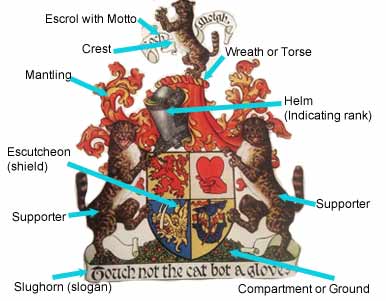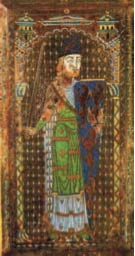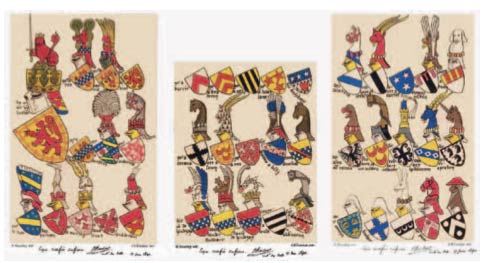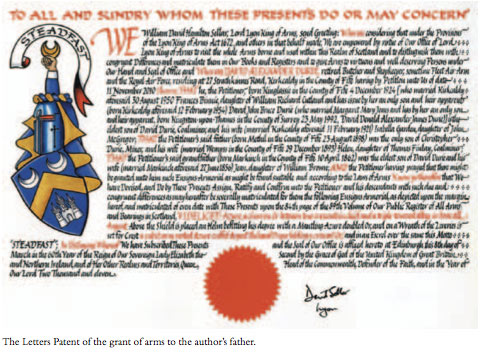Introduction to Scottish Heraldry
Why heraldry is useful

Detail of the Edinburgh Coat of Arms on the West Bow well, dated 1674.
Heraldry is all around us – on buildings, in stained-glass windows, on bookplates, school and club badges, regimental banners and the like, on signs at the entrance to towns, carved on chairs, engraved on family silver, depicted on pub signs (‘The Such-and-Such Arms’) and at various times during the year displayed on standards up and down Edinburgh’s Royal Mile. In fact, heraldry is hard to avoid once you start to notice it.
Often, it is discounted as some sort of medieval relic, or obscure symbolism of no relevance today. But heraldry is alive, well and thriving, and no place has such a well-developed and tightly regulated system of heraldry as Scotland. It is also of central importance in genealogy, as a coat of arms is a pictorial shorthand of an individual’s family tree.
The components of an achievement of arms
It is best to start with an understanding of what a coat of arms consists of. Below is an ‘achievement’ of arms with its various components.

- Shield – also known as the escutcheon, the main and most recognisable component of the arms, often used on its own
- Helmet – the actual configuration of this denotes the rank of the armiger
- Wreath – also called a torse, this has the same colours as the mantling (below)
- Mantling – this takes the main colours of the ‘livery’ (the overall coat of arms, banners etc.). It probably started as protection from the sun in the Holy Land, where the crusaders realised that wearing a metal pot on the head in the blazing sun was an invitation to having your brains fried. They noticed that the locals wore a cloth, held down by a burnous (the origin of the wreath or torse, above), to keep the sun off.The mantling is usually depicted cut and tattered (in a very florid and stylised way) to indicate the sword-play of battle
- Crest – this arises from the wreath (below) and is the element used in a Crest Badge; it was physically worn atop the helmet and served as a further identifier of the armiger
- Motto – in Scottish arms, the motto should be at the top, but this is often ignored in, for example, civic arms on buildings
- Coronet of rank – if the armiger is noble, the coronet will indicate baron, viscount, earl, marquess, duke, prince or sovereign
- Supporters – not everyone merits supporters, but where granted they are usually animals, humans or mythical beats of some sort
- Compartment – in Scotland, the supporters always stand on a compartment or ground, which is sometimes adorned with the family’s plant or flower
- Slughorn – as well as the motto at the top there may be a subsidiary slogan under the compartment, often the war-cry of the clan, for example
How did arms originate?
Arms started from the necessity to identify knights and nobles on the battlefield and at jousting tournaments after the invention of the barrel helmet, which completely covered the face. There are no examples of arms as we know them (unique, heritable designs on shields etc.) among the Normans, as a look at the Bayeux Tapestry will confirm. (See www.tapestry-bayeux.com and be aware that it wasn’t made in Bayeux, and isn’t a tapestry – it was embroidered in wool, possibly in either Winchester or Canterbury, England, and probably by nuns of noble Saxon background.) There was no need for identifiable arms because the Norman fighting men wore an open helmet with a nose-guard.
With the need to identify warriors uniquely, the practice arose of painting a high-contrast design possibly first on a banner, standard or other flag, and then on the linen surcoat worn over armour to keep it clean, hence the term ‘coat of arms’. This naturally spread to the whole livery – the shield and even the horse’s caparison. Here is a particularly florid example of this in plate, showing James I of Scotland.

The King of Scots – Fifteenth-century armour, tabard and horse trappings.

The funerary enamel on the tomb of Geoffrey V, Count of Anjou (d. 1151)
Although the Normans had no heraldry in the sense that we understand it – the use of individual and inheritable emblems borne on armour – and therefore did not introduce it to the British Isles, the practice had already started in Europe, probably around Flanders. By the time of Henry I of England, it had started to take root in England – there is an account in 1127 of Henry knighting his son-in-law Geoffrey V, Count of Anjou, and placing around his neck a shield painted with golden lions. When Geoffrey died (1151) the funerary enamel on his tomb at Le Mans Cathedral depicted him bearing a blue shield emblazoned with golden lions.This may be the first recorded portrayal of a British coat of arms.
By this time coats of arms were considered heritable by the children of armigers throughout Europe. There are seals dating from the 1130s and 1150s showing a figure of the owner bearing a design on his shield, and by the end of that century, the heraldic design appears as the single device on armorial seals.
The earliest Scottish heraldic artefacts are from the late 1100s and early 1200s – the armorial seals of Allan, 2nd Hereditary High Steward of Scotland from 1177, showing the typical fess chequy of the Stewart coats of arms still seen in Scots heraldry today. The earliest documentary references to a ‘King of Arms of Scotland’ are said to be in an English exchequer record of 1297 (which the author has never seen), and one in an Exchequer Roll of 10 October 1337 for a payment of £32 6s. Scots for the making of seventeen armorial banners. But there are mentions of Lord Lyon in Scottish documents from 1318, and of other Scottish heralds in 1327 and 1333. The office of Lord Lyon dates at least to the reign of Robert Bruce in 1318, but the role probably grew out of that of Shennachie (Gaelic seanachaidh) from the ancient Celtic tradition.The earliest mention of a ‘Lord Lyon King of Arms’ is in 1388, with a record of a payment to ‘Leoni regi heraldorum’. However, as we have seen, heraldry was well established in Scotland before the year 1200.

armorial seals of Walter FitzAllan (1140–1204), 3rd Hereditary High Steward of Scotland, from whom the Stewarts/Stuarts descend.

The fess chequy of a Stewart coat of arms
The first truly Scottish armorial dates from 1508, but there are Scottish arms in the Balliol Roll – believed to be of English origin dating from the 1330s – in the Armorial de Gelré (c. 1369–88), in the fifteenth-century Armorial of the Toison d’Or, and there are armorial seals from c. 1200.The first mention of a herald with an official title seems to be from 1365, when there is a confirmation of a charter by David II to John Trupour or Trumpour, ‘nunc dicto Carric herald’ (now called Carric Herald’, and Carrick Pursuivant is still the title of one of the Officers of Arms in Scotland). There is a record of a payment to a herald in 1377, and on 8 April 1381 a warrant was issued in London allowing the ‘Lion Heraud’ of the King of Scots to take a suit of armour he had bought there.
Heralds and armorials
The Lord Lyon is the senior heraldic authority in Scotland with wide-ranging and statutory powers over the granting and usage of armorial bearings.
Heralds had ambassadorial status from the earliest times, and were trusted emissaries of the King with the equivalent of diplomatic immunity. As arms proliferated,someone had to keep a record of what these were, and ensure that there were no duplications. From this came a system of Armorials (pictorial and textual descriptions of coats of arms).
The first roll of arms was the mid-thirteenth century Chronica Majora by Matthew Paris. Another early armorial was the Dering Roll (c. 1270–80). It soon became the practice for heralds to swap these at battles, and they were copied for the benefit of other knights and nobles. Similarly, at jousting tournaments in later centuries, heralds controlled the fixture lists.These even crossed the continent – there are three folios illustrating the arms of some Scottish nobles and knights in the Flemish Armorial de Gelré, collated between 1370 and 1414.

Scottish coats of arms emblazoned in the Armorial de Gelré (c. 1369–88).


Books
The two best publications are: Mark Dennis’ beautifully illustrated and remarkably affordable ‘Scottish Heraldry’ (available from the Heraldry Society of Scotland), and the out-of-print ‘Simple Heraldry Cheerfully Illustrated’ (1952), which can often be found on eBay or other auction and bookselling websites.
More formal works are: Sir Thomas Innes of Learney’s ‘Scots Heraldry’, 2nd edition (Edinburgh: Oliver and Boyd, 1956) or the edition revised by his son Malcolm Innes of Edingight (Edinburgh: Johnston & Bacon, 1978); J.H. Stevenson’s ‘Heraldry in Scotland’ reproduced in a one-volume Centenary edition b Bruce Durie; George Seton,’The Law and Practice of Heraldry in Scotland’ (Edinburgh: 1863). Others worth checking are: Stephen Friar, Heraldry for the Local Historian and Genealogist (Alan Sutton, 1992), and Sir James Balfour Paul,The Scots Peerage (various editions, 1904–14).
Sir James Balfour Paul, ‘An Ordinary of Scottish Arms’, Volume I, 2nd edition (Edinburgh:William Green and Sons, 1908) and Volume II (Edinburgh: 1977) list arms recorded in the Public Register of All Arms and Bearings in Scotland from 1673.
Online sources
- Heraldic dictionaries etc. – Notre Dame: www.rarebooks.nd.edu/digital/heraldry/index.html
- Heraldry Society of Scotland: www.heraldry-scotland.co.uk – The Society publishes a journal, ‘The Double Tressure’, and a newsletter, ‘Tak Tent’, and has regular meetings in Edinburgh and outings throughout Scotland.
- Heraldry Society (UK): www.theheraldrysociety.com
- Database compiled from some of the published visitations of various counties: http://ukga.org/heraldry/index.html
- FrançoisVelde’s Heraldry Site: www.heraldica.org/
- The British Heraldic Archive: www.kwtelecom.com/heraldry/
- Canadian heraldry: www.heraldry.ca/
- Coats of Arms from Ireland and around the World (Eddie Geoghegan): www.heraldry.ws/
- Cambridge University Heraldic & Genealogical Society: www.cam.ac.uk/societies/cuhags/links/her_info.htm
- List of Scottish Armorials: www.heraldry-scotland.co.uk/mitchell-rolls.html
- Arthur Charles Fox-Davies, Complete Guide to Heraldry (first published in 1909): www7b.biglobe.ne.jp/~bprince/hr/foxdavies/index.htm.
This information was kindly supplied by Dr Bruce Durie:
Dr. Bruce Durie BSc (Hons) PhD OMLJ FSAScot FCollT FIGRS FHEA
Genealogist, Author, Broadcaster, Lecturer
Shennachie to the Chief of Durie
Shennachie to COSCA
Honorary Fellow, University of Strathclyde
Member, Académie internationale de généalogie
E: bruce@durie.scot
W: www.brucedurie.co.uk






